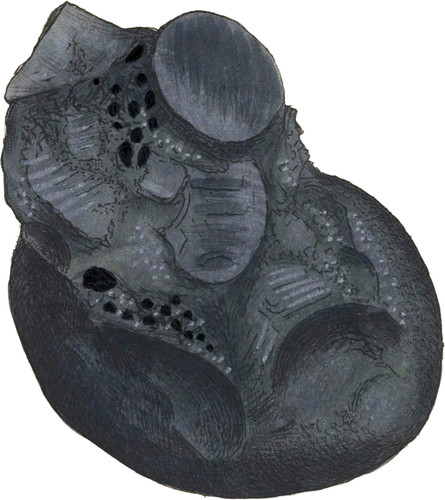 Enlarge
Enlarge
British Mineralogy
Talcose Breccia
- Class 2. Earths.
- Order 2. Aggregate.
Having, through the interestof my kind friend Dr. Penneck of Penzance, received from Mr. Joshua Came fine specimens of the Grey Slate Pebbles, spoken of by him to our mutual friend Davies Giddy, Esq, M. P., I thought it doubly incumbent on me to give a figure of it; first from respect to the donors, and next on account of its curiosity when examined in a geological point of view. I cannot describe it more satisfactorily than partly in Mr. Carnc’s own words*. It is observed that “The Relistian mine is nearly on a level with the surrounding country—the lode has been seen at the depth of 12, 25, 50, 65, 75, 81, and 90 fathoms from the surface. It is of different widths at different parts; the extreme width is 36 feet, and in this part it is principally worked. As it extends east and west, which is its due course, its width gradually diminishes, till at the distance of 100 fathoms east it is but 5 feet wide. It is composed, excepting the metallic part, of Schist†, Chlorite (in a distinct form), and Quartz. In some parts the Schist predominates, and in others the Chlorite; the Quartz is throughout the smallest component part. The engine shaft is situated 8 fathoms north of the widest part of the lode. In sinking the shaft, a flookan about two inches wide was discovered, bearing a south-east course, which cuts the lode at an angle of about 45°, and heaved and disordered it.
“At the depth of 12, 25, and 50 fathoms, nothing was discovered in the lode but the cavities from which the ore was taken away during the former period of working the mine. At 60 fathoms in depth were found, close to the flookan, a great number of angular fragments of Schist cemented by the same substance. At the depth of 75 fathoms the flookan became 4 inches wide in the shafts and continued of that size for 10 fathoms; it then became divided into four parts or branches, each diverging from its former course, and in this state it continued through the lode, of which the first three feet were composed of Copper Pyrites, and then was discovered a body of Pebbles nearly twelve feet square, extending in width to the extreme branches of the flookan. In this part of the lode the Schist greatly predominates; of course the pebbles are generally composed of Schist, cemented in some parts by the same substance or Chlorite, in others by Oxide of Tin, which is generally crystallized; and in some of the crevices there is a little Copper Pyrites, It is singular, that a few pebbles, perhaps not more than half a score, were found of quite a different nature from the others; they were composed of Tin in Quartz coated with Chlorite. The pebbles did not continue in a body to the height of more than two fathoms; but scattered bunches and single pebbles were found four fathoms above, and six fathoms below the place in which they were first discovered.
“It is only necessary to add, that the lode has since been worked fifteen fathoms deeper than where the pebbles occurred; it there consists for the most part of Chlorite, in a regular manner; not the least trace of pebbles is to be seen, nor indeed of any disturbance in the strata.”
Merely rounded pebbles of Slate would, to a common observer, appear extraordinary. Here we see the particular decomposition of a primitive rock where it was least expected; and the Oxide of Tin, which, in most cases, seems coeval with the common Chlorite, Slate Rock, or Killas of the Cornish miners, seems again crystallized, if I may use the expression; and these new crystals generally differ from the former, and are truly curious as to the variety of their modifications, being excellent practice for a crystallographer. The Chlorite Which serves to cement the pebbles, as before observed, is crystallized; and I find it, like tab. 182 of this work, in six-sided plates. Among the partly crystallized Quartz in my specimen, are some rather shattered interrupted fragments of white Fluor‡. The Sulphuret of Copper, or Copper Pyrites, is rather in amorphous fragments, and there are some very brilliant crystals of decomposing Iron pyrites, a few of which are beautifully iridescent.
Besides the specimens which I have received from Dr. Pen neck and Mr. Came, I have been favoured with one by Dr. Turton, showing the Sulphuret of Copper.
- * Phil, Trans. 1807. Part ii, p. 293.
- † Consisting chiefly of greyish green Talc or Chlorite.
- ‡ This has so much the appearance of shattered Quartz at first sight, that I imagine it might be all taken for Quartz. It burns beautifully phosphorescent; which id rather curious fur white Fluor.

